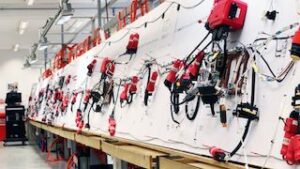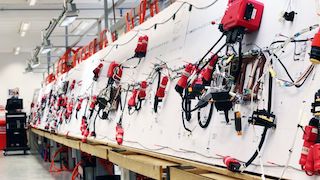ADAPTING HIGH-SPEED AUTOMOTIVE TECHNOLOGIES FOR AEROSPACE WIRE HARNESS TESTING
This article looks at the heritage of real-time testing in the automotive sector, and how the R&D team at MK Test have succeeded in adapting this technology to meet the demands of testing wire harnesses for the aerospace manufacturing industry. Written by Sally Antilles, MK Test systems.
There are numerous examples of the automotive sector being ahead of aerospace when it comes to new manufacturing technologies or processes. The concept of the production line itself is an obvious example; we all know the story of Ford. Lean production, 3D printing, and even augmented reality were all widely implemented within car manufacturing before being adopted by countless other sectors including A&D.
Another recent technology to be adopted by aerospace is e-vehicles. In 2021, battery-powered cars have become mainstream, with charging points commonplace at motorway services and garage forecourts. Meanwhile, the first commercial all-electric aircraft are not planned for flight until 2026.
Through history, as cars became more driven (pun very much intended) by electronics, so too did aircraft with the first ‘fly-by-wire’ airliner launched by Concorde in 1969.
Why is this? Automotive R&D and methods teams are focused on faster and cheaper manufacturing and are also racing to implement new technologies for the end-user before their competition does. In contrast, aviation tends to focus on implementing process or technology associated with safety and quality. A report on quality management notes that “Aerospace has adopted many well-established ideas, practices and…solutions from the automotive industry, borrowing from those lessons to drive future progress as the aerospace industry goes through it’s own era of rapid technological advancement.” (EASE, 2016.)
Methods engineers in the large aerospace OEMs – Airbus and The Boeing Company – are increasingly crossing over from the automotive sector. Time and cost savings are evergreen KPIs within manufacturing, and for these, automotive beats aerospace. Experts from the automotive sector are bringing their knowledge of technological gains and systemic improvement methods – such as high-speed testing – to aerospace. Paul Meloche is VP Sales for Fori Automation, a Michigan-based business who have successfully transitioned from the automotive sector to also supplying support vehicles for aerospace assembly. In a 2014 interview, he said “During the downturn of the economy, a lot of automotive engineers started filtering out into aerospace companies. [These companies] are more receptive to learn from automotive suppliers because many aerospace engineers have seen automotive automation in action, and we offer them a different view on things.” (Schoenberger, 2014).
As a technology business predominantly working with aerospace customers, MK Test Systems turned to auto for inspiration with their latest round of R&D; a high-speed test system named RTS (Real Time Scanning). A major aerospace OEM customer approached MK seeking ways to improve upon the current method of wire harness testing at their FAL stage, with the goal of improving aircraft manufacturing speed.
Heading up the RTS project team was Nick Baker, New Product Development Manager at MK Test. He summarized the adaptation by saying “Automotive is very much a pass-fail industry. The wiring either works or it doesn’t. In aerospace, you’re testing for resistances and taking measurements much more accurately. The RTS system is designed for that kind of pass-fail testing, but with vastly improved accuracy. Not only are we saying ‘yes, it’s passed’ but we were also able to provide a resistance measurement to within ± 0.5Ω.”
Using real-time scanning technology for aircraft testing meant adapting several elements. The project was a significant R&D investment for MK Test Systems and took two years from initial concept to the first customer signing off the system.
RTS began by looking at the drawbacks of the current system. Of key concern were length and number of interface cables, hook-up time, and the fact that testing could only take place at the end of the final assembly. The ongoing headache of cable maintenance, and testing hook-up time is a stand-out bottleneck in the production process – testing comes at the end of manufacturing and can take 3 full shifts.
The customer’s current system uses a standard 19” rack construction. The large footprint of the rack means it needs to be positioned away from the plane under test. This therefore requires a huge amount of interface cables to connect to the aircraft. So far, so standard. The system and its physical set-up are extremely common and in line with what is typically found at aircraft FALs around the world. But at a time when Industry 4.0 looks to digitize as much as possible to simplify manufacturing, ‘standard’ is beginning to feel outdated.

Looking at all these points holistically, the two overriding requirements were the actual speed of the test and the ability to identify the types of faults as quickly as possible. From this, it became apparent that a version of a real-time scanning system – as commonly used in automotive – was the best solution. RTS enables operators to see in real time where the failure is and to fix it immediately, rather than carrying out a full test before going through the results and fixing the faults later.
On a standard eTester system, the switching modules are normally in the cabinet, with a huge amount of interface cables – typically up to 170km of wire for a full aircraft – running across the shop floor and into multiple locations around the aircraft. The maintenance and physical usage of interface cables is a massive burden on time and money. Not only is the maintenance extensive and expensive, but the hook-up is time-consuming and messy. The RTS system has eliminated much of this burden by miniaturizing the switching modules and positioning them inside the aircraft, so typically there are now only 8 umbilical cables for a full aircraft test system.

Not only is RTS fast, but it’s safe. Addressing the need for speed meant looking at how the operators could carry out testing during the build process rather than waiting until the end. High voltage testing is perceived as inherently dangerous, which is why testing can’t typically be carried out alongside manufacturing with equipping teams inside the aircraft. However, discussions with the customer determined that HV testing was carried out at several previous stages so were unnecessary at FAL. RTS operates at low voltage and low current, which enables operators to work around the system whilst it’s running tests. It’s taking some getting used to, but Baker believes it has the potential to be a huge benefit for the aerospace industry: “When we demonstrated it, people ask if it’s running, and I love that. They’re so used to hooking up, hitting run, hearing the slow relays clicking, waiting for it to finish and see the results. But RTS is just going all the time. The behavioural change of just hitting go at the start, and then plugging it all in and watching the green lights come on as you build; that’s a big gain for the industry.”
RTS is now in use by a major aerospace OEM on their final assembly line in France. Another RTS project is in development with a different customer for testing aircraft power panels. The system is best suited to high pin count and high connector count assemblies, formboard harness tests, and for carrying out in-vehicle installed harness tests.
In summary, automotive technologies can drive innovation in aerospace, with adaptation made possible by knowledge of aerospace systems. RTS is the result of a collaborative approach to engineering, drawing from expertise in both sectors.
About MK Systems
MK Test Systems was established 30 years ago in 1992 and are a world-leading manufacturer of automatic electrical testing systems. The systems are widely used within the aerospace, rail, defence, subsea, power & control industries worldwide to ensure high performance electrical systems are correctly wired and undamaged. With the main headquarters in Wellington, Somerset, the company has satellite offices in the US and Hong Kong, as well as a network of partners and distributors offering sales, service, and support around the world. Please contact Sally Antilles, Marketing Manager (+44 (0)1823 661100, [email protected]) for all enquiries.
References:
- Schoenberger, R. (2014). From cars to planes. Aerospace Manufacturing and Design, [online]. Available at https://www.aerospacemanufacturinganddesign.com/article/amd1114-aerospace-assembly-automation/ [accessed 15 April 2021].
- Ease (2016). From Automotive to Aerospace: Key Cross-Industry Learnings on Quality Management [online]. Available at https://www.ease.io/automotive-to-aerospace-quality-management-cross-industry-learnings/ [accessed 12 April 2021].






























































